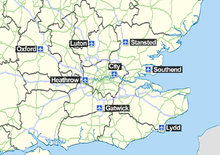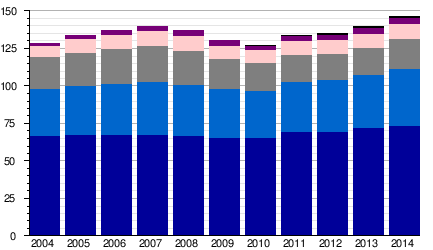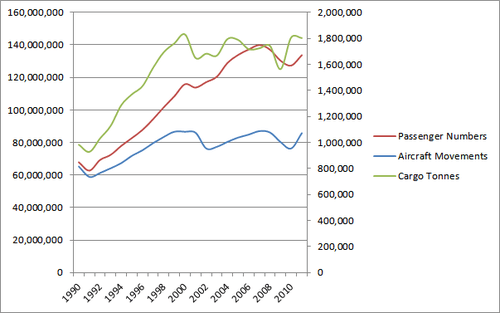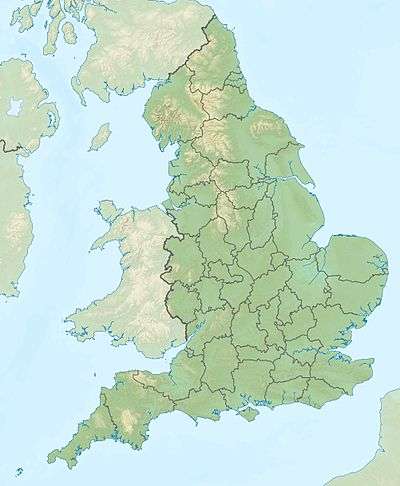Airports of London
The metropolitan area of London, England, United Kingdom is served by six international airports and several smaller airports. Together, they make the busiest airport system in the world by passenger numbers and the second-busiest by aircraft movements.[1] In 2018, the six airports handled a total of 177,054,819 passengers. The London airports handle over 60% of all the UK's air traffic. The airports serve a total of 14 domestic destinations and 396 international destinations.
International airports
| Airport | IATA | ICAO | Distance to London[3][4] | Total of passengers
2018 |
Total of aircraft movements 2018 | Total of 2015 passengers[5][6] | Change from 2011[5][6] | % of 2015 passengers | % of 2011 passengers | Cargo (tonnes) | Change from 2010 | Aircraft movements[7] | Change from 2011 |
|---|---|---|---|---|---|---|---|---|---|---|---|---|---|
| City | LCY | EGLC | 14 km (9 mi) | 4,820,292 | 78,036 | 4,319,301 | 2.78% | 2.23% | 70,781 | ||||
| Heathrow | LHR | EGLL | 26 km (16 mi) | 80,102,017 | 480,339 | 74,985,748 | 48.30% | 51.88% | 1,484,351 | 475,176 | |||
| Gatwick | LGW | EGKK | 45 km (28 mi) | 46,075,400 | 283,926 | 40,269,087 | 25.94% | 25.36% | 88,085 | 256,987 | |||
| Luton | LTN | EGGW | 55 km (34 mi) | 16,581,850 | 136,270 | 12,263,505 | 7.90% | 7.12% | 27,905 | 96,797 | |||
| Stansted | STN | EGSS | 63 km (39 mi) | 27,995,121 | 185,660 | 22,519,178 | 14.50% | 12.94% | 202,593 | 143,511 | |||
| Southend | SEN | EGMC | 64 km (40 mi) | 1,480,139 | 17,088 | 900,648 | 0.58% | 0.45% | 6 | 27,715 | |||
| Total | N/A | N/A | N/A | 177,054,819 | 1,181,319 | 155,257,467 | 100.00% | 100.00% | 1,802,939 | N/A | 1,070,967 |
City (LCY)
Located in the London Borough of Newham, City Airportmap5 is situated in London's Docklands, and is the closest to central London, which limits its size—the airport has a single runway, which is very short. As a result, no large aircraft are permitted to use the airport, which initially prevented all long-haul flights. However, since 2009, British Airways has operated a flight to New York JFK, via Shannon, using an Airbus A318. The largest aircraft currently handled at the airport is the Airbus A220-100, slightly larger than the Airbus 318, with increased range and capable of taking off from London City fully loaded. Its first commercial flight completed in August 2017 from Zurich.[8]
Located only four miles from Canary Wharf, London City Airport is often used by business travellers, with many flights serving destinations across the UK and northern Europe. The airport cannot be expanded due to the docks on either side. It is also the only airport serving London which does not operate at night.
A light rail service from London City Airport DLR station, which adjoins the terminal building of London City Airport, links it to the financial district of the City of London at Bank and Monument stations, which offer interchanges with London Underground.
Heathrow (LHR)
Located in the London Borough of Hillingdon, Heathrowmap1 is by far the largest of London's airports and considered the main gateway into the United Kingdom for non-European visitors. Heathrow has four terminals and two parallel runways. Due to the location in London's western suburbs, Heathrow has had trouble trying to expand, with various expansion projects being cancelled.[9] As a result, the airport consistently runs at over 99% capacity and is often included on lists of the worst-rated airports in the world.[10] However, on 1 July 2015 Heathrow's expansion plan was suggested as the best option by the Airport Commission and on 25 October 2016 a new northwest runway and terminal was approved by the Government.
The airport is connected to Great Britain's motorway network via the M4 and M25 motorways, to London Paddington station by Heathrow Express[11] and TfL Rail[12] trains and to other Central London destinations by London Underground trains on the Piccadilly line.
In April 2012, Heathrow announced that for the first time in history it handled 70 million passengers in a calendar year,[13] making it the third busiest airport in the world in terms of passenger numbers, after Atlanta and Beijing. It also comes second behind Dubai International Airport in the list of the busiest airport in the world in terms of international passenger numbers, as well as being the busiest airport in Europe by total passenger numbers.
Heathrow serves six continents around the world, and is the base for the flag carrier British Airways in Terminal 5. While it also serves short-haul flights, Heathrow is London's long-distance hub and is the most popular arrival point for flights from the United States of America, with 13 million passengers. However, because it is operating at capacity, Heathrow has failed to increase service to cities in the newly industrialised countries such as China, falling behind European bases like Frankfurt, Amsterdam, and Paris.
Gatwick (LGW)
Located in West Sussex, Gatwickmap2 is the second-busiest airport in the United Kingdom, the eighth-busiest in Europe, and the second-busiest single-runway airport in the world. It handles flights to more destinations than any other UK airport[14] and is the main base of easyJet,[15] the UK's largest airline by number of passengers.[16] Also using it as a base are British Airways, Norwegian Air Shuttle and TUI Airways.
The airport consists of two terminals, North and South, is connected to the motorway network via the M23 and has its own railway station, with Southern and Thameslink trains serving London Victoria and London Bridge stations respectively as well as there being a dedicated Gatwick Express shuttle to and from London Victoria.
Luton (LTN)
Located on the Bedfordshire / Hertfordshire border, Luton Airportmap4 is London's fourth-largest airport, the fifth-busiest in the United Kingdom and the third-closest to the capital, after Heathrow and City airports. The two airlines supplying most passenger capacity are the low-cost carriers easyJet and Wizz Air.
Luton Airport Parkway railway station can be reached from London St Pancras in as little as 22 minutes via East Midlands Railway, while Thameslink is the primary operator, with slower but more frequent services. A shuttle bus service connects Luton Airport Parkway to the airport, a distance of just over a mile.
Stansted (STN)
Located in Essex, Stanstedmap3 is London's third-busiest airport, being the fourth-busiest in the United Kingdom, behind Manchester Airport, 22nd-busiest in Europe and the largest operational base for Ryanair, which is Europe's largest low-cost carrier and the world's largest international airline by number of international passengers.[17] Stansted serves more scheduled European destinations than any other airport in the UK,[18] as well as some destinations further afield. It is the home of Harrods Aviation, allowing VIP aircraft to land there, such as Air Force One carrying the President of the United States, Barack Obama, in 2009 and also 2016, also President Donald Trump in 2017 and 2019.[19]
Stansted Airport railway station is situated in the terminal building directly below the main concourse.[20] Services to Central London are on the Stansted Express train to and from London Liverpool Street.
Southend (SEN)
Located in Essex, Southend Airportmap6 expanded commercial air transport operations to destinations in Ireland in 2011, and to mainland Europe in 2012 when easyJet commenced operations using the brand new terminal and railway station. Southend claims it only takes 15 minutes to go through arrivals from plane to train with hand luggage. It was the third-busiest airport in the United Kingdom from the 1960s until the end of the 1970s, when it was overtaken in passenger numbers by London Stansted Airport.[21][22]
Southend Airport railway station is served by Abellio Greater Anglia trains, which connect the airport to London Liverpool Street station up to 8 times per hour. The journey to London takes about one hour.[23]
Other airports
Though not generally considered London airports, Birmingham Airport and Southampton Airport have been suggested as alternative airports for London due to the existence of direct rail links serving Central London.[24] Birmingham Airport has argued that High Speed 2, once complete, would make it an attractive option for London passengers.[25]
Other civil airports

A number of other airports also serve the London area.
Open airports
The following are mainly used by general aviation flights.
- London Biggin Hill Airportmap7, in the London Borough of Bromley
- Blackbushe Airportmap8, in Hampshire
- Damyns Hall Aerodromemap9, in the London Borough of Havering
- Denham Aerodromemap10, in Buckinghamshire
- Elstree Airfieldmap11, in Hertfordshire
- Fairoaks Airportmap12, in Surrey
- Farnborough Airportmap13, in Hampshire
- London Heliportmap14, in the London Borough of Wandsworth
- Lydd Airport (London Ashford Airport)map15, in Kent
- North Weald Airfieldmap16, in Essex
- London Oxford Airportmap17, in Oxfordshire
- Redhill Aerodromemap19, in Surrey
- Rochester Airportmap20, in Kent
- Stapleford Aerodromemap21, in Essex
- White Waltham Airfieldmap22, in Berkshire
- Wycombe Air Parkmap23, in Buckinghamshire
Closed airports
Airports are listed at their current borough, although the area may have been outside London at the time of construction.
- Panshanger Aerodromemap18, in Hertfordshire
- Cricklewood Aerodromemap24, in the London Borough of Barnet
- Croydon Airportmap25, in the London Borough of Croydon
- Great West Aerodromemap26, in the London Borough of Hillingdon
- Hendon Aerodromemap27, in the London Borough of Barnet
- Heston Aerodromemap28, in the London Borough of Hounslow
- Hounslow Heath Aerodromemap29, in the London Borough of Hounslow
- London Air Park (Hanworth Air Park)map30, in the London Borough of Hounslow
- Stag Lane Aerodromemap31, in the London Borough of Barnet
Royal Air Force stations
There were several Royal Air Force stations in London. This list excludes those that are classed as non-flying stations.
Operational
- RAF Northoltmap32, in the London Borough of Hillingdon, also handles civil flights
Non-operational
Station are listed at their current borough, although the area may have been outside London at the time of construction.
- RAF Biggin Hillmap7, in the London Borough of Bromley
- RAF Fairlopmap33, in the London Borough of Redbridge
- RAF Hendonmap27, in the London Borough of Barnet
- RAF Hestonmap28, in the London Borough of Hounslow
- RAF Hornchurchmap34, in the London Borough of Havering
- RAF Kenleymap35, in the London Borough of Croydon
- RAF St Pancrasmap36, in the London Borough of Camden
- RAF Uxbridgemap37, in the London Borough of Hillingdon
Proposed airports
Thames Estuary
Due to London's high capacity, in particular London Heathrow, Boris Johnson, London's former mayor (Current Prime Minister), and Sir Norman Foster have both brought up plans to have a new airport built, either on a man-made island in the Thames Estuary, or on the Isle of Grain in North Kent. Foster's proposed Thames Hub Airport would be very similar to the design of Hong Kong International Airport and Qatar's Hamad International Airport. The plans to have an airport able to handle 110 million passengers a year would require the closure of Heathrow, and probably make the new airport the busiest in the world.
The plans have met with opposition from some people living nearby warning the airport would create a significant increase in bird strikes.[26] Other people and local businesses, recognising the depressed levels of economic activity in North Kent, have been supportive and argue that London needs a new airport in order to be able to compete in the world.
Traffic and statistics
Passengers numbers
 |
| Updated: 28 April 2015.[27] |
| Heathrow, Gatwick, Stansted, Luton, City, Southend |
Cargo numbers

Change
| Year | Aircraft movements | Percentage change | Passenger numbers | Percentage change | Cargo tonnes | Percentage change |
|---|---|---|---|---|---|---|
| 2001 | 1,074,773[28] | 113,790,381 | 1,649,437 | |||
| 2002 | 954,570[29] | 117,138,188 | 1,682,693 | |||
| 2003 | 967,270[30] | 120,493,239 | 1,667,803 | |||
| 2004 | 1,005,256[31] | 128,933,753 | 1,795,326 | |||
| 2005 | 1,038,241[32] | 133,836,827 | 1,788,671 | |||
| 2006 | 1,060,831[33] | 137,192,958 | 1,717,360 | |||
| 2007 | 1,087,703[34] | 139,950,593 | 1,724,040 | |||
| 2008 | 1,077,448[35] | 137,106,041 | 1,743,028 | |||
| 2009 | 1,003,616[36] | 130,307,938 | 1,563,783 | |||
| 2010 | 954,371[37] | 127,353,419 | 1,808,005 | |||
| 2011 | 1,072,126[7] | 133,709,327 | 1,802,939[38] | |||
| 2012 | 1,060,967[7] | 134,914,412 | 1,805,761[39] | |||
| 2013 | 1,067,992[7] | 139,652,261 | 1,760,690[39] | |||
| 2014 | 1,098,605[7] | 146,631,158 | 1,819,587[39] |
Busiest routes
In total, there were 30 international destinations from London, and another 3 domestic routes, that handled more than 1 million passengers in 2011:
| Destination | Number of passengers |
|---|---|
| 3,705,696 | |
| 3,026,082 | |
| 2,700,613 | |
| 2,506,613 | |
| 2,496,921 | |
| 2,376,284 | |
| 2,218,593 | |
| 1,814,682 | |
| 1,678,536 | |
| 1,661,301 | |
| 1,656,818 | |
| 1,642,959 | |
| 1,546,441 | |
| 1,530,810 | |
| 1,526,030 | |
| 1,412,749 | |
| 1,302,237 | |
| 1,299,118 | |
| 1,207,424 | |
| 1,197,847 | |
| 1,189,761 | |
| 1,186,783 | |
| 1,186,358 | |
| 1,185,848 | |
| 1,145,011 | |
| 1,134,396 | |
| 1,069,706 | |
| 1,069,055 | |
| 1,031,320 | |
| 1,003,598 |
Heathrow Airport is a major hub for flights across the North Atlantic. In 2011, 11% of all north Atlantic flights originated or terminated at Heathrow, more than Paris and Frankfurt combined, and Heathrow is the European terminus for 11 of the 25 busiest north Atlantic routes.
The busiest long-haul route in the world is between London (Heathrow and Gatwick) and New York (JFK and Newark), with a total of 3,898,460 passengers travelling between the two cities in 2011.
Maps
- ^map1 Heathrow, 51°28′39″N 000°27′41″W
- ^map2 Gatwick, 51°08′53″N 000°11′25″W
- ^map3 Stansted, 51°53′06″N 000°14′06″E
- ^map4 Luton, 51°52′28″N 000°22′06″W
- ^map5 City, 51°30′19″N 000°03′19″E
- ^map6 Southend, 51°34′13″N 000°41′36″E
- ^map7 Biggin Hill, 51°18′51″N 000°01′47″E
- ^map8 Blackbushe, 51°19′26″N 000°50′51″W
- ^map9 Damyns Hall, 51°34′43″N 000°14′44″E
- ^map10 Denham, 51°35′18″N 000°30′47″W
- ^map11 Elstree, 51°39′21″N 000°19′33″W
- ^map12 Fairoaks, 51°20′53″N 000°33′31″W
- ^map13 Farnborough, 51°16′31″N 000°46′39″W
- ^map14 Heliport, 51°28′12″N 000°10′46″W
- ^map15 Lydd, 50°57′22″N 000°56′21″E
- ^map16 North Weald, 51°43′18″N 000°09′15″E
- ^map17 Oxford, 51°50′13″N 001°19′21″W
- ^map18 Panshanger, 51°48′07″N 000°09′30″W
- ^map19 Redhill, 51°12′49″N 000°08′19″W
- ^map20 Rochester, 51°21′07″N 000°30′10″E
- ^map21 Stapleford, 51°39′09″N 000°09′22″E
- ^map22 White Waltham, 51°30′03″N 000°46′28″W
- ^map23 Wycombe, 51°36′42″N 000°48′30″W
- ^map24 Cricklewood, 51°33′47″N 000°12′47″W
- ^map25 Croydon, 51°21′23″N 000°07′02″W
- ^map26 Great West, 51°28′39″N 000°27′41″W
- ^map27 Hendon, 51°36′00″N 000°14′46″W
- ^map28 Heston, 51°29′15″N 000°23′00″W
- ^map29 Hounslow Heath, 51°27′41″N 000°23′20″W
- ^map30 London Air Park, 51°26′18″N 000°23′45″W
- ^map31 Stag Lane, 51°35′49″N 000°16′26″W
- ^map32 RAF Northolt, 51°33′11″N 000°25′06″W
- ^map33 RAF Fairlop, 51°36′16″N 000°06′10″E
- ^map34 RAF Hornchurch, 51°32′19″N 000°12′17″E
- ^map35 RAF Kenley, 51°18′12″N 000°05′41″W
- ^map36 RAF St Pancras, 51°32′01″N 000°07′29″W
- ^map37 RAF Uxbridge, 51°32′29″N 000°28′19″W
See also
References
- Beijing to overtake London as world's largest aviation hub. Massive new airport planned
- "Size of Reporting Airports 2011" (PDF). Archived from the original (PDF) on 10 July 2012. Retrieved 10 June 2012.
- "How to get into the city from London's airports", wind.com.
- https://www.londontoolkit.com/travel/southend.html. Accessed: 2018-06-02. (Archived by WebCite® at https://www.webcitation.org/6zsruMgEK)
- "Domestic Terminal Passenger Traffic 2012(a)" (PDF). Archived from the original (PDF) on 25 October 2012. Retrieved 10 June 2012.
- "EU and Other International Terminal Passenger Traffic 2012" (PDF). Archived from the original (PDF) on 23 May 2014. Retrieved 10 June 2012.
- Aircraft Movements 2012
- "Swiss completes first CSeries revenue flight to London City". Flightglobal.com. 8 August 2017.
- "Heathrow third runway plans scrapped by new government". BBC News. 12 May 2010. Retrieved 21 April 2011.
- Alan Travis, home affairs editor (3 May 2012). "Official waiting time figures reveal scale of Heathrow chaos | World news". The Guardian. London.
- https://www.webcitation.org/query?url=https%3A%2F%2Fwww.heathrowexpress.com&date=2018-05-19
- 2018-06-26. URL:https://www.heathrow.com/transport-and-directions/trains/tfl-rail. Accessed: 2018-06-26. (Archived by WebCite® at https://www.webcitation.org/70TNT8C5K)
- Lucy Tobin (12 April 2012). "Record 70 million use Heathrow airport - Business News - Business". The Independent. London.
- "Gatwick by Numbers - Gatwick Airport". www.gatwickairport.com. Archived from the original on 16 June 2018. Retrieved 20 May 2018.
- "Where We Are - easyJet CareerseasyJet Careers". careers.easyjet.com.
- "Airline data annual reports 2017 - UK Civil Aviation Authority". www.caa.co.uk.
- "Domestic bliss". The Economist.
- Based on IATA schedules for August 2016
- "G20". Harrodsaviation.com. Retrieved 31 October 2012.
- stanstedairport.com - To & From the Airport retrieved 25 April 2017
- EasyJet Helps Make Southend London's Sixth Major Airport London.net, published 16 June 2011. Retrieved 17 June 2011
- EasyJet to offer flights from Southend Financial Times, published 16 June 2011. Retrieved 17 June 2011
- "London Southend Airport - Trains – General Information". southendairport.com. Archived from the original on 7 January 2016.
- Elledge, John (1 July 2019). "How many airports does London have? | CityMetric". CityMetric. Retrieved 1 March 2020.
- "Airport 'near to London with HS2'". BBC News. 23 February 2011. Retrieved 1 March 2020.
- Juliette Jowit (26 January 2012). "Risk of bird strikes would make Thames Estuary UK's 'most dangerous airport' | Environment". The Guardian. London.
- "UK Airport Statistics" (PDF). Caa.co.uk. 26 March 2015. Archived from the original (PDF) on 3 April 2015. Retrieved 28 April 2015.
- Aircraft Movements 2001 Archived 3 February 2004 at the Wayback Machine
- Air Transport Movements(a) 2002 Archived 14 October 2015 at the Wayback Machine
- Air Transport Movements(a) 2003 Archived 14 October 2015 at the Wayback Machine
- Air Transport Movements(a) 2004 Archived 22 September 2015 at the Wayback Machine
- "Air Transport Movements 2005" (PDF). Archived from the original (PDF) on 19 September 2012. Retrieved 31 October 2012.
- "Air Transport Movements 2006" (PDF). Archived from the original (PDF) on 25 September 2015. Retrieved 31 October 2012.
- "Air Transport Movements 2007" (PDF). Archived from the original (PDF) on 24 January 2012. Retrieved 31 October 2012.
- "Air Transport Movements 2008" (PDF). Archived from the original (PDF) on 10 September 2012. Retrieved 31 October 2012.
- "Air Transport Movements 2009" (PDF). Archived from the original (PDF) on 28 September 2012. Retrieved 31 October 2012.
- Air Transport Movements 2010 Archived 8 July 2015 at the Wayback Machine
- Air Transport Movements 2011 Archived 27 September 2012 at the Wayback Machine
- "Air Transport Movements 2004-2014" (PDF). Archived from the original (PDF) on 3 April 2015. Retrieved 28 April 2015.
